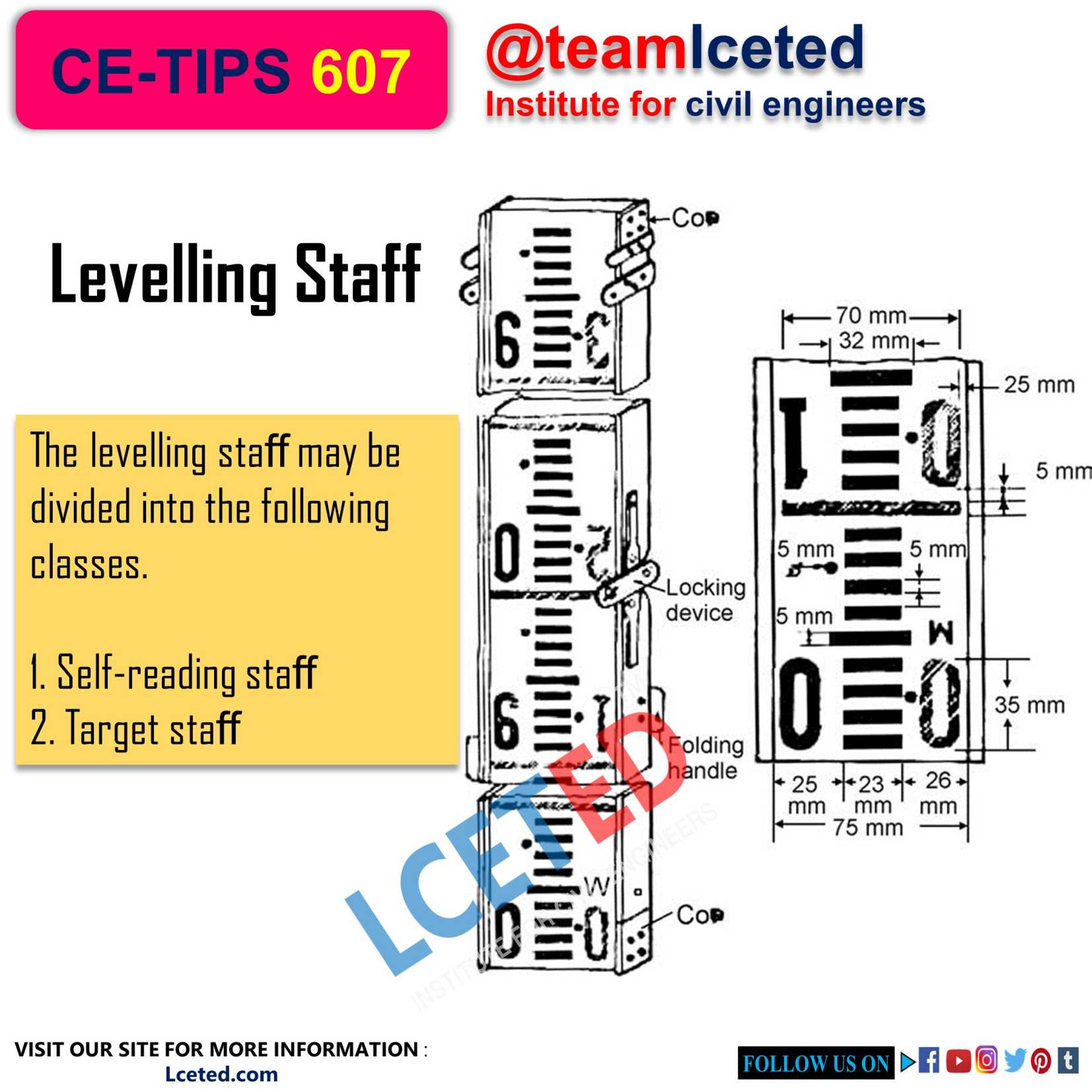LEVELLING STAFF
The reading given by the line of sight on a levelling staff held vertically is
the height of the line of collimation above the point on which the staff is held
(Below Figure). The levelling staff may be divided into the following classes.
1. Self-reading staff
2. Target staff
SELF-READING
STAFF
A staff on which readings are directly read by the
observer through the telescope is known as self-reading staff. Self-reading
staffs are of three types as discussed below.
Solid staff
These are usually 3 m long.
Due to the absence of a hinge or socket on these staffs, greater accuracy in
reading is achievable, but on the other hand, it is inconvenient to carry them
in the field. The use of a solid staff is generally restricted to precise levelling
work.
Folding or hinged staff
A folding staff is made of
well-seasoned timber. It is 4 m long and consists of two portions, each being 2
m long and hinged together. The width and thickness of the staff is kept at 75
mm and 18 mm, respectively. The foot of the staff is provided with a brass cap
to avoid wear and tear due to usage. Sometimes, a plummet is also provided to
test the verticality of the staff. Each metre length is subdivided into
decimetres and each decimetre is further divided into 20 equal divisions of 5
mm width. Decimetre numerals 1–9 for each metre length are marked in black and
metre numerals in red.
The graduations are marked
inverted so that they appear erect when viewed through the telescope. In modern
levelling staff, the graduations are marked erect. The staff may be folded
together so that one 2 m piece is capable of folding on the other when not in
use and two pieces are detachable from one another so that one half may be used
while working in plain areas.
Telescopic
or Sopwith type staff
It is made up of three
pieces. The top piece is solid 1.25 m long, whereas the central piece of 1.25 m
length and the lower piece of 1.5 m length are hollow. The top portion slides
into the central portion telescopically. When fully extended, the total length
of the staff is 4 m. The upper two pieces are held by brass spring catches. The
smallest division of this type of levelling staff is also 5 mm. The metre
numerals, which are shown on the left, are marked in red. The decimetre
numerals 1–9 are shown on the right and marked in black. The decimetre number
10 of each metre length is omitted and the letter M is marked to indicate the end
of the metre length. Graduation is marked erect and when viewed through the
telescope it appears inverted. While using a telescopic staff it may be ensured
that the three parts are fully extended in length when using the full length,
i.e., 4 m
TARGET
STAFF
The target staff consists of
two rods, one sliding over the other. The two rods are held together by means
of brass clamps. Raising the sliding can extend the length of the staff. The
face of each rod is graduated in feet, tens and hundredth of a foot, while the
back of a sliding rod is similarly graduated, but from the top downwards. The staff
is provided with a movable target equipped with a vernier. With the help of
this vernier, one can read up to 0.001 ft. The sliding rod carrying the target
is bisected by the line of sight.
Holding a staff for taking a reading
Care should be taken to
hold the levelling staff truly vertical while the reading is being taken. To
hold the staff in a vertical position, the person holding the staff should stand
behind the staff with his heels together, having the heel of the staff between
his toes and holding it in his hand at the height of his face. When the level
of the required point is very much higher than the height of the instrument, an inverted staff reading is to be taken.
Relative merits of self-reading and target staff
a. With the self-reading staff, the readings can be taken
quicker than with the target staff.
b. In the case of target staff, the services of trained
personnel are necessary.
c. The reading with the target staff can be taken with
greater fineness. But if the staff man does not direct accurately to make the
line of sight bisect the target, it gives more apparent readings.
d. The surveyor himself takes the reading on a
self-reading staff. But in the case of target staff, the staff man is responsible
for noting down the readings.
e. It is tedious to adjust the target such that the line
of sight bisects it accurately.
Fundamental axes of a levelling instrument
a. Line
of collimation or principal line of sight: It is the imaginary straight line that joins the optical centre of the object-glass with the point
of the intersection of crosshairs of the diaphragm.
b. Axis
of bubble tube: It is an imaginary line tangential to the
longitudinal curve of the tube at its middle point. It is also known as the bubble
line. It is horizontal when the bubble is centred.
c. Axis
of the telescope: It is a line joining the optical centre of
the object-glass to the centre of the eyepiece.
d. The
vertical axis: It is the imaginary line passing through
the centre line of the axis of rotation.
e. The
height of the instrument (HI): The height of the instrument is the elevation of the plane of collimation or plane of sight when
the instrument is correctly levelled. When a level in adjustment is accurately
levelled, the line of collimation will revolve in a horizontal plane known as
the plane of collimation or plane of sight.
If you find
This information is helpful, please share it.
Thanks! For reading the article.









No comments:
Post a Comment